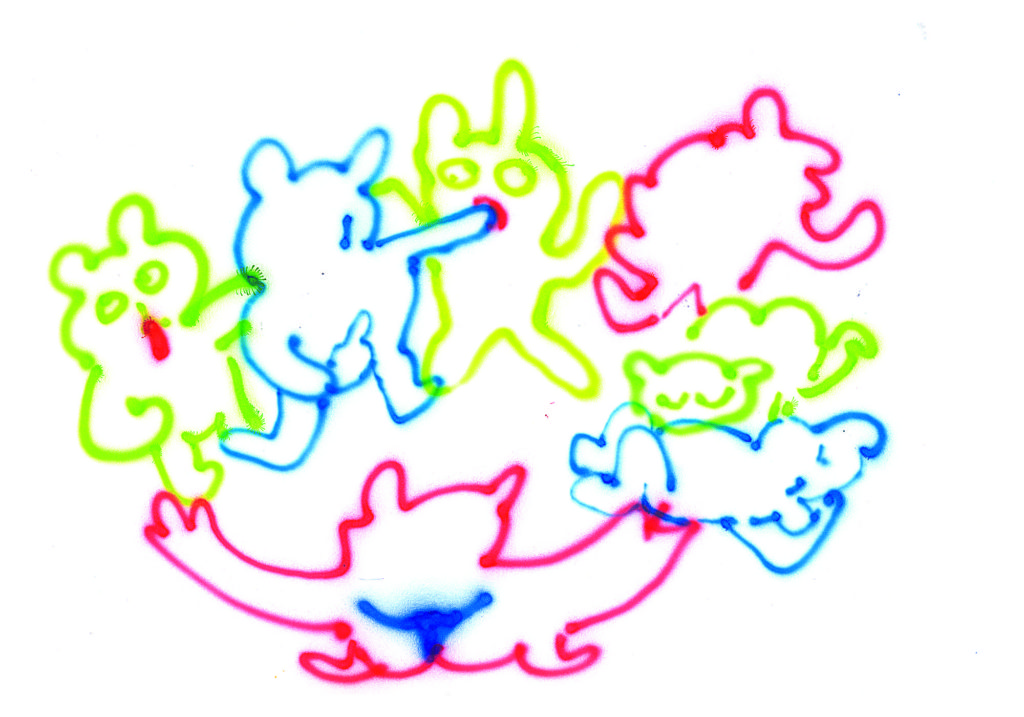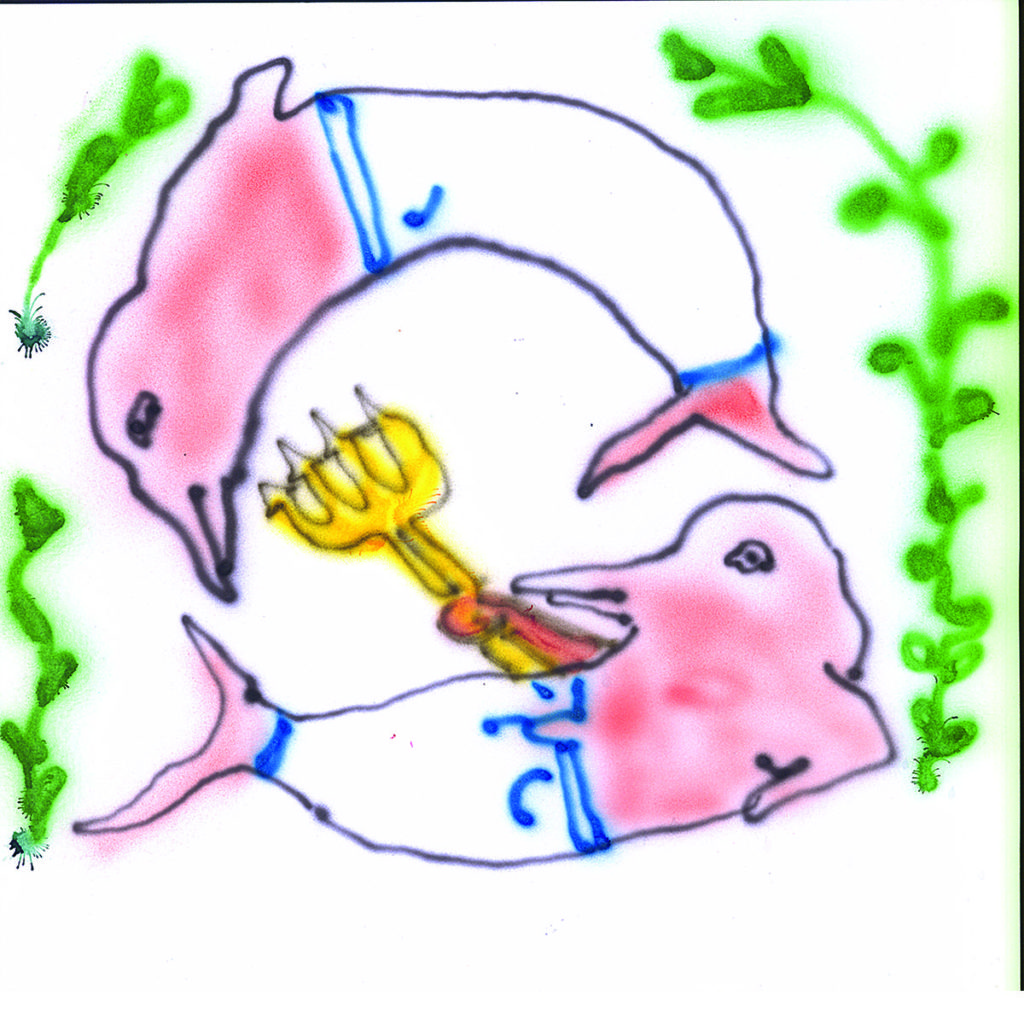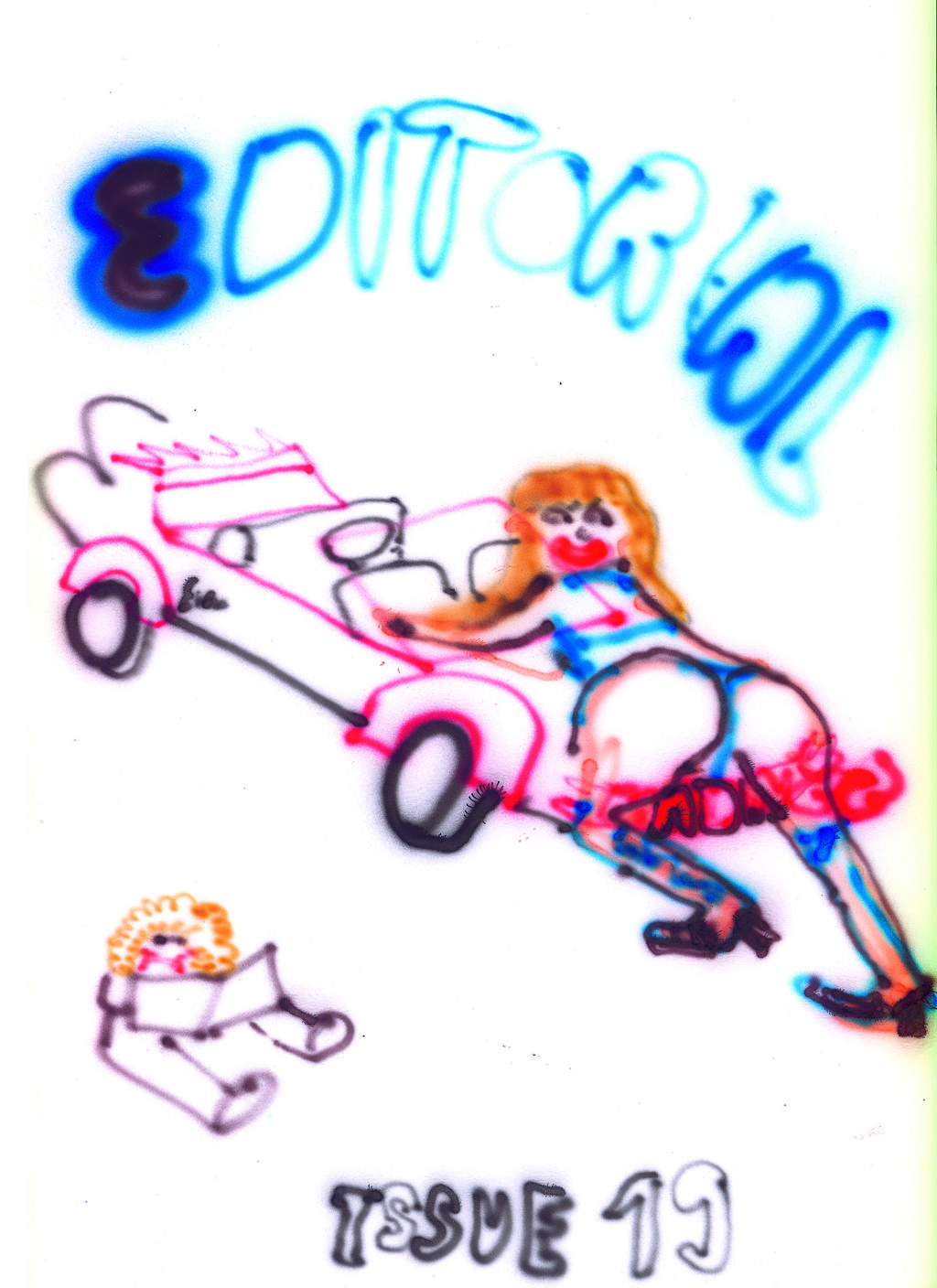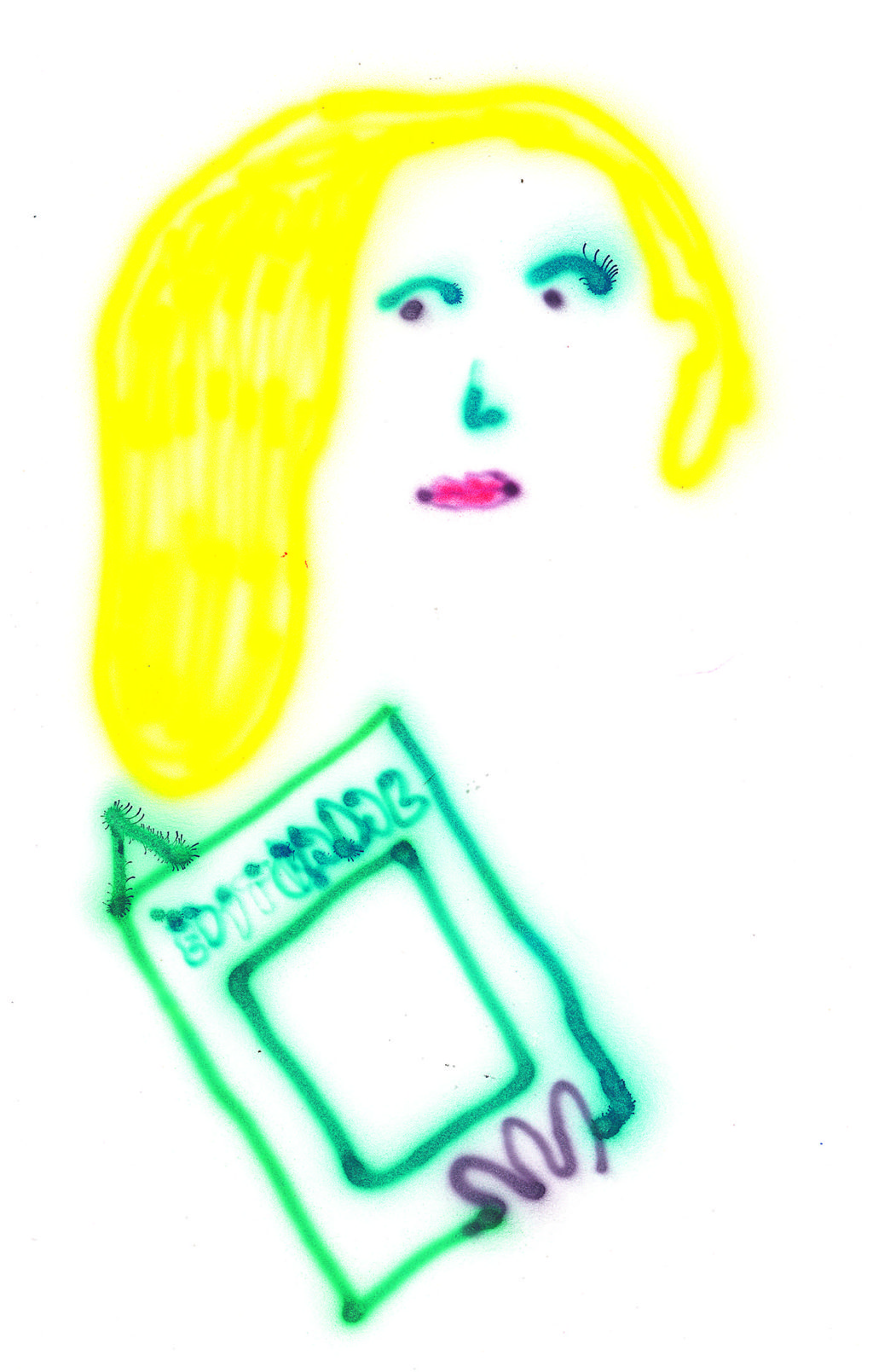IT’S JULY 2019 AND IT’S VERY HOT. TISSUE MAGAZINE CALLS CLAIRE MILBRATH FROM THE ROOF OF SCHLOSS ISENBURG, THE OLD CASTLE ON THE CAMPUS OF THE UNIVERSITY OF ART & DESIGN IN OFFENBACH. WHICH IN ITSELF IS ODD: USUALLY TISSUE’S EDITORIAL ACTIVITIES ARE CONFINED TO THE APARTMENT-COME-OFFICE OF TISSUE’S EDITOR-IN-CHIEF. SOMETHING THAT CLAIRE HERSELF IS USED TO: SHE HAS BEEN RUNNING EDITORIAL MAGAZINE FROM HER BEDROOM IN MONTREAL FOR YEARS. BUT THAT’S JUST THE NEW NORMAL: AS THE MAGAZINE’S EDITOR-IN-CHIEF, WHO IS ALSO MAKING A CAREER AS A PAINTER, CLAIRE SAYS SHE NEVER REALLY TAKES MEETINGS IN PERSON ANYWAY.
INTERVIEW: UWE BERMEITINGER
ILLUSTRATIONS: ANNA HOFMANN
Hi Claire — from bedroom editor to bedroom editor — how are you? What are you doing right now as we speak?
I am in L.A. at my friend’s house and it is 11 am. I just woke up and right now I’m having my first coffee. Fantasia, the exhibition I curated, opened at Steve Turner Gallery here in L. A. two days ago and it went well.
It is so good to talk to you. Over the last few years I felt quite burned out by the magazine business and in general. I saw satan everywhere. For me, only Editorial Magazine stood out from the rest, although I tried to ignore it for a long time. I am still quite fascinated by everything: the attitude, the layout, the content. With contributions from Drake Carr and Louise Bonnet, and with your own paintings as well, it’s a visual universe of its own. Speaking of which, does running a magazine affect your painting practice, or has the role of your own artistic work changed over the years?
Back then, I started the magazine to publish my friend’s artwork and my own paintings. The initial plan was to start the magazine to build my own painting career and then ditch the magazine when I managed to get a gallery. Now I am really busy painting, but I don’t want to give up Editorial Magazine. It feels like my baby. So now I’m trying to combine these two things. It’s pretty hard, I still need to figure it out better. I rely on the juxtaposition between my painting and my work with Editorial Magazine. Painting makes me feel like a child, I get to use my imagination and be vulnerable. Working on the magazine means a lot of organizing, and I feel more like an adult running a business. So I kind of need both to keep me sane.
I never wanted to make a magazine to publish my own photographs. For me, the magazine is an artwork on its own and I am happy to just curate it. You said that you started Editorial Magazine to find a place to publish your own artwork. Did your plan to make your paintings popular with the help of your magazine work out?
Yes, it really did. I find it funny because it seems to be a faux-pas to put your own work in your own magazine. I’ve never been precious with Editorial Magazine, so l didn’t want to follow any specific or unspoken rules about what one is supposed or not supposed to do. I knew that people would think, ‘Why is the editor putting her own paintings into the magazine?’ But I didn’t really care.
Now you have to decide whether to be an artist or an editor or both. This question created a major crisis for me. Four years ago, when I quit the printed version of TISSUE Magazine, I felt like I had to decide whether to professionalise the magazine and actually earn money with it to pay my team and contributors and stuff … But I was afraid to sell out in the process of monetising it.
I can relate to that so much as I hate the pressure, too. Being an editor is actually a creative task, then you are expected to turn it into a functioning business with an office space and paid staff and I don’t have the skills to do that. All I want to do is spread nice art and create a magazine that is cool to look at.
Back to your paintings: they seem very special. People tend to compare them to Matisse. What’s your vision and what moves and inspires you to paint?
The Matisse comparison is funny. When I first started painting, I would copy Matisse paintings and sell them to pay my rent. At first people just wanted them because they were obsessed with Matisse. But other painters inspire me more. I love looking at the masters but also at emerging artists. Currently, I find myself obsessed with the American painter Grant Wood, whose painting American Gothic is the one with the farmer couple standing in front of their farm. I’ve also been studying his landscapes and these hypermasculine shirtless farm boys that are very sexual, also I’m unsure whether that was intentional or not. Classical music inspires me. I want my paintings to be mini melodramas — big dramatic scenes. I like listening listen to Tchaikovsky as loud as my speakers go while I’m painting.
What are you currently working on? Do you have any exhibitions or contributions lined up? What are your plans for the next few months?
I am very excited to be taken the next month off. After releasing our latest issue, I immediately started working on the Fantasia exhibition. Now I need a little break to get my ideas in order and then I have to get started on Editorial Magazine No. 20. It will be very special as it is going to be an anniversary. I am bad at scheduling, so I can’t tell you when it will be out. I used to do an issue of Editorial Magazine in three months and now it takes me about a year, because I care so much more. I want every page to have lots of things to look at.
Please explain to our readers: What are the everyday struggles of being the editor-in-chief of Editorial Magazine?
I find it really hard. You start a thing and suddenly you realise ‘Oh, I’m actually running a business and I need to make a profit and get people paid.’ I am struggling so much with that because I hate networking and invoicing. I feel like I am supposed to make Editorial Magazine a self-sustaining business, but I just can’t do that and I don’t know how other magazines do it. They probably have a team.

Henri Matisse, La danse [1909]
We totally feel you. The moment it is about money the spirit is gone. It will lose quality because it is not about the content anymore.
There is a bonus to financial restriction. I feel like Editorial Magazine will never turn into a big publication, it is always going to be an independent magazine.
Also, how did you come up with that name? For us as non-native speakers, how are we supposed to interpret the title, is it a VETEMENTS-like joke?
(Laughs) People always have something to say about the name. Some hate it, some think it is hilarious. I chose it because I wanted to have something straight-forward. It is a bit ironic and some people think it is an inside joke. Honestly, I just wanted it to sound like a big magazine and that having your art published in Editorial Magazine means that you’re doing great work. I wanted to use it as a way to make my friends’ and my own art seem important. Editorial Magazine sounds official.
Editorial Magazine is a true DIY publication. You started to lay out a magazine without any editorial knowledge and pre-print skills. Still, there must have been a big love for magazines and other printed matter. I cannot believe you started the magazine by accident.
I had never read magazines and I had never bought a magazine, so it actually was incidental how it happened. Stanley Kubrick said: ‘If I had known anything about film making, I would have never started it.’ So, if I had known anything about making magazines, I would have probably never started either.
Would you consider your first issue of Editorial Magazine as sort of a comment on magazines in general? One could see it as institutional critique in a situationalist context.
Yes, I do — we even put fake fashion credits into it. I wanted it to be like Vogue magazine. It is crazy looking at the first issue, the font is so big. I didn’t know what I was doing and didn’t think about all the design aspects laying out the magazine broke my brain.

Grant Wood, American Gothic [1930]
It also relates to your painting. You intuitively started to copy or appropriate something and it turned out to be a good thing — very inspiring.
Thank you.
Speaking of DIY and because I have spoken to a lot of other independent publishers over the years: are you still working from home, or do you have an office space to run the magazine from?
Basically, nothing has really changed. I still do Editorial Magazine in my bedroom in Montréal. My editor used to be my room-mate. We just got our own places as we thought it was time to grow up. She is the only one that gets paid on a regular basis. All the others freelance. People imagine an editor going to photo shootings or doing studio visits, but I never leave my house to see anybody. I never do meetings or anything like that.
Alongside ‘art and fashion’, is there any other — maybe deeper — message or vision?
I want to keep my commitment to emerging artists or people that have never been published before. My favourite thing about Editorial Magazine is finding an artist who is doing great work and has never been featured anywhere. I want to give that platform to them. I never wanted to have a mission for the magazine. Everyone always wants to know what the concept of Editorial Magazine is, but I never want to define it because I want it to be shape-shifting. I am already losing interest in fashion and I’d rather have educational articles.
Yes, fashion got slow and boring.
Exactly. And I can’t get over the fact that when we are talking about fashion we are selling clothes to people and mostly it is very expensive fashion. I only want to feature people that have good personal style instead of having to give credits to the brand in the shoots. Advertisers will probably hate me.

Cover of Editorial Magazine N°19 [2019]
From issue N°1 to issue N°19, from 2011 to 2019, what has changed?
That is a long time. I have learned so much but at the same time nothing has really changed. I kind of resist change because I want Editorial Magazine to stay the same. I do not want it to have a crazy amount of structure. The content is what has changed the most over the years. I care a lot more about the quality of the content, which is why I take a full year to put an issue together. I want to have way more articles and good things to read in the magazine, but structurally nothing has changed at all. It is still just me and my editor.
What does it take to create an issue of Editorial Magazine? What are the main stages you go through?
I start to make a list of artists I like. When I decide it’s time to do a new issue, I reach out to everybody I am working with to get ideas going. I don’t like giving people deadlines that are too strict. Sometimes I just say, ‘Write me in a month with some ideas!’. Artists take so long and it’s cool because there is no need to rush it. I like to give my contributors the carte blanche, that way they have artistic freedom. Sometimes they need three months to put an article together and that’s fine.
What are your main layout inspirations? Sometimes it looks like a teen magazine layout-wise.
(Laughs) It’s true. I love ’90s teen magazines. My friend just bought a house and in the basement there are all these boxes of porn magazines from the ’60s and ’70s. So she keeps sending me these porn magazines and I look at them all the time for design inspiration.
One big question which might not be easy to answer: what about the internet?
I really like this question. I would be a different person without the internet, because I don’t like going out and meeting people in person. Even talking on the phone right now … I never talk on the phone. I have met so many great people on the internet. All the artists in Editorial Magazine started out that way. I feel lucky. I am part of the last generation that grew up without the internet. I have my childhood and I rely on it so much. Do you think the internet is a threat to print magazines?
No, without the internet most independent magazines wouldn’t get a worldwide audience. But it’s also true that because of the internet you don’t really need magazines anymore.
Yes, there are so many blogs on the internet. But when you put something out on a blog, it disappears in the stream, whereas with print you’re making a cultural artefact.
I once read that all the issues of Editorial Magazine are sold out. As a fairly headstrong publication, how does this happen, what’s your strategy on that one?
When I first started, I issued 300 copies. That is all the money I could borrow from people. Now, that I have a couple of advertisers I can do a real print run. So, they do not really sell out right away. I still have so many copies of issue No. 17 and No. 18 available, but I think our last issue, No. 19, will be sold out by now.
Finally, what are the most important things you have learned thus far as editor-in-chief of Editorial Magazine?
To be more thick-skinned when it comes to drama. There is so much drama when you are making a project as there are so many things that can go wrong. Also, amongst artists, there are a lot of divas out there.
I used to be really sensitive when things didn’t work out and used to get depressed for a few days. But now, I know that it is par for the course.
Visitez:
www.the-editorialmagazine.com



